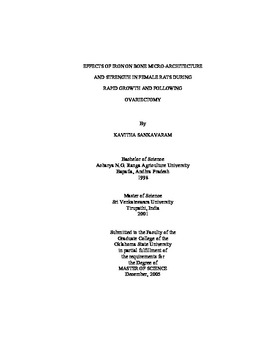| dc.contributor.advisor | Arquitt, Andrea B. | |
| dc.contributor.author | Sankavaram, Kavitha | |
| dc.date.accessioned | 2014-04-15T22:01:34Z | |
| dc.date.available | 2014-04-15T22:01:34Z | |
| dc.date.issued | 2005-12-01 | |
| dc.identifier.uri | https://hdl.handle.net/11244/9275 | |
| dc.description.abstract | This study investigated the effects of varying levels of dietary iron on bone micro-architecture and strength of female rats. Weanling rats were fed with one of three levels of dietary iron: 6 ppm, 35 ppm or 150 ppm. At 18 weeks of age growing rats were killed and bones were collected. Ovariectomy was performed to mimic menopause or sham-operated as controls at 18 weeks in the other two groups. After 30 weeks of age both sham-operated and ovariectomized rats were killed and bones were collected. Right femur and fifth lumbar (L5) vertebrae were used for analyzing the bone micro-architecture and strength using micro-computed tomography (CT-40, SCANCO MEDICAL AG, Zurich, SW). Iron deficiency significantly decreased L5 architecture (Tb.N, Tb.Sp) and strength (Phy_fce, Strain, Stiffness, SIS) and increased Von Mises in growing rats. Femur architecture indicated by degree of anisotropy (DA) but not strength was affected by diet. Sham L5 architecture (BV.TV, Tb.N) was significantly greater and DA was lower indicating better quality bone than in OVX. A diet x treatment interaction was found for connectivity density with greater density in the 150 ppm sham rats. Shams had significantly greater L5 strength (Phy_fce, Strain, Stiffness, SIS) with a diet x treatment interaction for Von Mises (35 ppm OVX greater than all others and 150 ppm OVX less than 6 and 35 ppm sham and OVX). No diet, treatment or interactions were found in any group in femur mid-shaft cortical architecture. Our findings suggest that dietary iron affects bone micro-architecture and strength in low iron fed growing animals but not in sham and OVX. The diet by treatment interactions suggests that high iron may be detrimental to some. However, it was not clear what levels of iron when combined with estrogen deficiency would be detrimental with aging. Our findings also suggest that the effect of iron changes with skeletal site since we found significant effects in lumbar bone but not on distal femur or midshaft. | |
| dc.format | application/pdf | |
| dc.language | en_US | |
| dc.publisher | Oklahoma State University | |
| dc.rights | Copyright is held by the author who has granted the Oklahoma State University Library the non-exclusive right to share this material in its institutional repository. Contact Digital Library Services at lib-dls@okstate.edu or 405-744-9161 for the permission policy on the use, reproduction or distribution of this material. | |
| dc.title | Effects of Iron on Bone Micro-architecture and Strength in Female Rats During Rapid Growth and Following Ovariectomy | |
| dc.type | text | |
| dc.contributor.committeeMember | Arjmandi, Bahram H. | |
| dc.contributor.committeeMember | Smith, Brenda J. | |
| osu.filename | Sankavaram_okstate_0664M_1583.pdf | |
| osu.college | Human Environmental Sciences | |
| osu.accesstype | Open Access | |
| dc.description.department | Department of Nutritional Sciences | |
| dc.type.genre | Thesis | |
